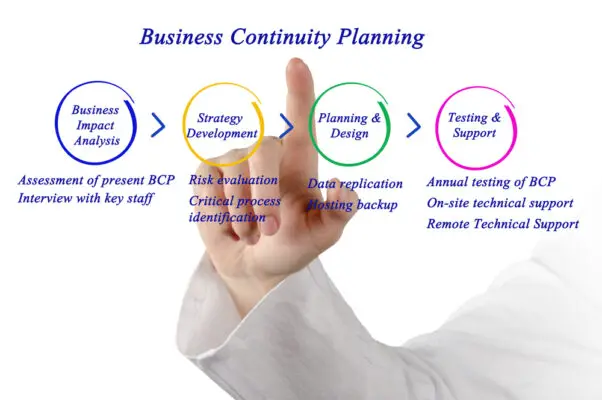An Incident Response Plan (IRP) and a Business Continuity Plan (BCP) are two key components of a comprehensive risk management strategy. They have different goals but can complement each other to help ensure your business is prepared for any disruption. Understanding the differences between these two plans can help you create a contingency plan that meets all of your business’s needs.
An incident response plan (IRP) and a business continuity plan (BCP) are two important documents that organizations should have in place to protect their data and operations. While they are both essential for any organization, they serve different purposes.
An incident response plan is designed to help an organization respond quickly and effectively to security incidents such as data breaches, malware attacks, or other cyber threats. Apart from the disaster recovery plan.
It outlines the steps that should be taken in each phase of incident response, including detection, containment, eradication, recovery, and post-incident analysis.
An effective IRP should also include roles and responsibilities for each team member involved in the process.
On the other hand, a business continuity plan is designed to help an organization prepare for unexpected events that could disrupt its operations. This includes natural disasters such as floods or earthquakes and human-caused disruptions like power outages or cyberattacks.
A BCP outlines the processes and procedures necessary for keeping critical operations running during these events. It also includes strategies for restoring normal operations once the event has passed.
Both an incident response plan and a business continuity plan are essential components of any organization’s cybersecurity strategy and key performance indicators for business continuity management.
They provide guidance on how to respond to incidents quickly and efficiently while minimizing disruption to operations so that businesses can remain secure and resilient in the face of any threat.

What is an Incident Response Plan?
An incident response plan (IRP) is a set of documented procedures that outlines the steps to be taken in the event of a security incident. It should include details on detecting, responding to, and limiting the consequences of malicious cyber activity.
The plan should also identify roles and responsibilities for security team members and provide guidance on how to communicate with stakeholders. Response procedures of service attacks and cyber incidents.
The incident response plan typically consists of six phases: preparation, identification, containment, eradication, recovery, and lessons learned. Preparation involves creating an inventory of assets and identifying potential threats.
Identification is when the security team identifies a malicious event or breach. Containment focuses on limiting the scope and impact of an attack by isolating affected systems or networks.
Eradication involves removing any malicious code or actors from the system. Recovery focuses on restoring normal operations while maintaining data integrity. Finally, lessons learned look at what went wrong during the incident and how it can be prevented in future incidents.
An IRP is designed to address specific incidents or emergencies. Incident response vs business continuity outlines how the organization will respond if it faces an incident or emergency, such as a natural disaster, security breach, or power outage.
The plan should include details on how to alert employees, customers, and other stakeholders; assign roles and responsibilities; assess the damage; take corrective action; and restore operations as quickly as possible.
It should also include information on where to find critical data, such as customer records or financial documents, in case they are destroyed or lost during the incident.
What is a Business Continuity Plan?
A BCP focuses more broadly on how to maintain operations in spite of disruptions. This could include anything from natural disasters to computer system malfunctions. Unlike an IRP, which focuses mainly on responding to an emergency after it has occurred, a BCP looks at ways to prevent potential disruptions from occurring in the first place by developing strategies for dealing with them if they do occur.
A well-crafted BCP will also provide guidance on testing processes and procedures before an incident occurs so that businesses can be sure their plans are effective when needed most.
What’s the difference between BCPs, DRPs, & Incident Response Plans
Business Continuity Plans (BCPs), Disaster Recovery Plans (DRPs), and Incident Response Plans (IRPs) are all important components of an organization’s contingency planning business continuity functions. BCPs are designed to help organizations prepare for and recover from any disruption, whether natural disasters, cyber-attacks, or other unforeseen events.
DRPs focus on the recovery of IT systems and data after a disaster or cyber incident has occurred. IRPs are specific procedures that should be followed when responding to a cyber-attack or other security incident.

Why is an Incident Response Plan Critical to Maintain Business Continuity?
The internet isn’t yet vulnerable to attacks, so it won’t happen. When you suffer unauthorized access to a computer network or other device, the effects may become overwhelming. Disaster Recovery Plans can help reduce risks and prepare for the future.
Recovery plans may reduce the time and cost associated with a security or data breach itself, allowing stakeholders to restructure forensic digital evidence to reduce recovery time, customer churns, and negative publicity. According to the Ponemon Institute, data breaches cost about $3.6m annually.
Who is Responsible for Developing an Incident Response Plan?
CSIRT will assess, classify and address security incidents if deemed relevant to the business. Incident response teams must be composed: Security experts should help and support the affected human resources,, and the team must execute technical and operational measures.
Incident response managers are responsible for the supervision of the investigation, surveillance, and recovery of a specific incident. The company will provide the firm with a severe breach to other employees, regulatory agencies, customer groups and the public if the breach happens.
The individual or team responsible for developing the IRP should have knowledge of the organization’s IT infrastructure and security policies. They should also have experience with incident response processes and procedures. In addition to developing the plan, they should also be responsible for training staff on how to use it in case of a security incident.
Developing Incident response plans and business continuity plans
Identify the Plan’s Objectives and Goals
Your goal is to maintain business continuity and ensure that you are unable to perform key activities in your essential business operations. These include key business operations throughout the organization: operations personnel, public relations, and communications.
However, each business has its own goal, which is crucial to its operation. It may be different according mainly to the type and size of the company. Once your goal is identified, map your strategic plans accordingly. Make sure the objectives are fully understood.
Identify the important business functions
When you’re considering whether your company will operate as an emergency response team or if your business needs other emergency management services, they need assistance. In addition to meeting customer needs, a company must maintain constant supplies of materials, keep track of inventories and meet ship-to-ship targets.
Identify the threat
The only way to reduce security threats accurately is by evaluating their severity. Start with infected hardware or patient zeros. The idea here is to find out who triggered the incident.
Only identifying the incident can give a reliable indication of deteriorating conditions. Instead of replicating the infected device, it is important that you find all the distinct indicators that indicate compromise that can then be used to search your entire property to find additional evidence of compromise.
Create an Incident Response Team
The response to incidents must involve a number of cross-functional leadership roles, as well as anyone else you believe is helpful within the group. Design a leader capable of making the right decisions and making consistent progress.
All staff members should have specialist knowledge in all technical and non-technical domains, a few examples of this include forensic investigations. Requiring outside specialists in incident handling.
Establish a communication plan
In the event of a catastrophe, a proper crisis communications plan is required. You need a communication strategy to communicate effectively with stakeholders within your own organization’s emergency management. In emergencies, communication may be limited by a sample message written for vendors, partners or staff. Incident response teams can improve their coordination of activity based on a carefully planned communication plan.
Conduct a Risk Assessment and Business Impact Analysis (BIA)
The BIA can identify significant threats to the organisation.
Keep the plan updated
Business continuity planning is essentially a long-term process. It should be evaluated continuously for its effectiveness. In emergency scenarios, teams may test their readiness through simulation tests. Based on data, adjust plans and review them.
Backup the important data
Take a copy of anything you can’t lose. Consider anything from client info through employee documents to company e-mail. The product also requires easy access in a disaster, enabling the firm to return quickly.
Many organisations store large amounts of information online but often rely upon paper documents. Contract documents, tax returns, and payroll documents have many examples. To prevent the loss of documents, use hard copies whenever possible.
What is the importance of an incident management plan?
Having ignored recent developments would have been a mistake, if not a major mistake. It’s essential to manage your business. Disruptions can be dangerous for companies – but even for smaller ones.
90% of small business owners are in financial trouble in a year. Those companies risk losing their customers, revenue, and good reputation.
Continue Business Operations
This helps maintain your business operation when a crisis strikes, reducing financial losses too. It gives everyone involved a sense of security and reassures them that your business will continue to grow. Communication across organizations is essential for keeping all employees informed.
It may cause problems in many organizations, with a large number of employees working remotely or with offices worldwide. Organisations should look at introducing solutions to facilitate instant, easy communication.
Gain competitive advantage
Make it easy to convince customers to come to your firm with an effective emergency response plan. How we respond to a crisis reflects much on our business reputation. Write an inspiring tale. Rapid thinking is a good way to be prepared to face the toughest competition.
Protect Your Supply Chain
Remember, natural disasters also affect suppliers. Assuring the distribution of risk across the supply chain ensures your plan provides for supply chain stability.
Reduce Financial Risk
Rapid action during a crisis can reduce the downtime in your business if needed. Longer downtime means greater costs and increased risks. Minimise the risk of damage by replacing functional items as quickly as possible.
Conclusion
When designing your organization’s risk management strategy, it’s important to consider both an Incident Response Plan and a Business Continuity Plan. While they have different goals—the former addressing specific incidents while the latter looking at broader strategies for maintaining operations—they can complement each other when properly implemented.

Chris Ekai is a Risk Management expert with over 10 years of experience in the field. He has a Master’s(MSc) degree in Risk Management from University of Portsmouth and is a CPA and Finance professional. He currently works as a Content Manager at Risk Publishing, writing about Enterprise Risk Management, Business Continuity Management and Project Management.


